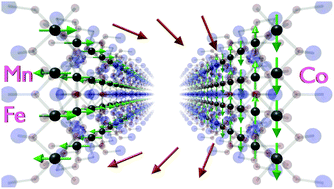The structures and magnetic properties of FexCo1−xSb2O4 and MnxCo1−xSb2O4, 0 ≤ x ≤ 1†
Abstract
MnxCo1−xSb2O4 and FexCo1−xSb2O4 have been synthesised for 0 ≤ x ≤ 1 and their structures and magnetic properties examined. For all compounds, neutron powder diffraction (NPD) data reveal a canted AFM structure that changes gradually from C-type (x = 0) to A-type (x = 1). This transition corresponds to a gradual rotation of the moments through 90°, from ±[001] to ±[100]. It is primarily caused by a change in the relative magnitudes of the three types of magnetic exchange that exist between cations. Within a given chain, direct exchange promotes an antiferromagnetic ground state for the two cations and 90° superexchange that favours ferromagnetic order. Between chains, antiferromagnetic order is preferred. However, the observed magnetic moments (from NPD) are significantly lower than expected except for the end-members of the series; this suggests that incomplete magnetic order is present. Magnetic susceptibility data also suggest complex magnetic behaviour except for the end-member compounds. The complex magnetic features appear to originate from composition inhomogeneity, local magnetic order in the chains of octahedra being dependent on small clusters of the same transition metal ion and the delicate energy balance that clearly exists between the two ordered configurations in the mid-composition region where x is near to 0.5.


 Please wait while we load your content...
Please wait while we load your content...